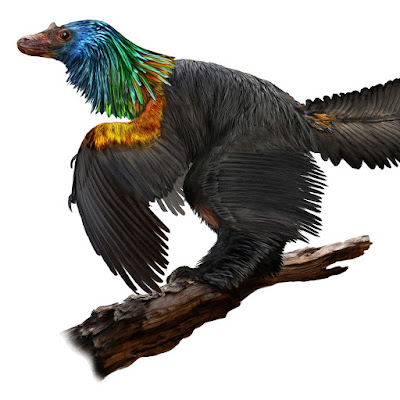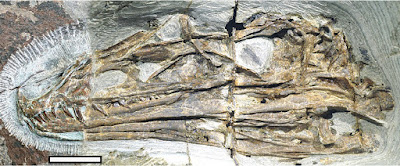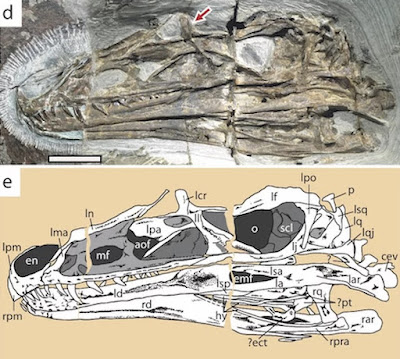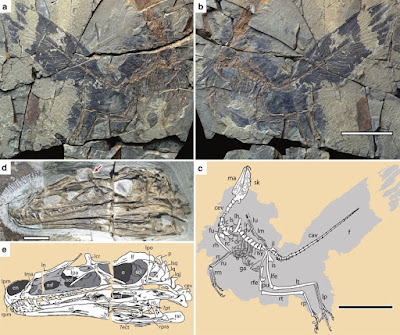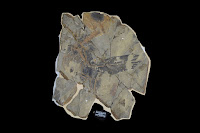[Most Recent Entries] [Calendar View]
Tuesday, January 16th, 2018
| Time | Event | ||||||
| 2:02a | [Paleontology • 2018] Caihong juji • A Bony-crested Jurassic Dinosaur with Evidence of Iridescent Plumage highlights Complexity in Early Paravian Evolution
Abstract The Jurassic Yanliao theropods have offered rare glimpses of the early paravian evolution and particularly of bird origins, but, with the exception of the bizarre scansoriopterygids, they have shown similar skeletal and integumentary morphologies. Here we report a distinctive new Yanliao theropod species bearing prominent lacrimal crests, bony ornaments previously known from more basal theropods. It shows longer arm and leg feathers than Anchiornis and tail feathers with asymmetrical vanes forming a tail surface area even larger than that in Archaeopteryx. Nanostructures, interpreted as melanosomes, are morphologically similar to organized, platelet-shaped organelles that produce bright iridescent colours in extant birds. The new species indicates the presence of bony ornaments, feather colour and flight-related features consistent with proposed rapid character evolution and significant diversity in signalling and locomotor strategies near bird origins.
Systematic palaeontology Theropoda Marsh, 1881 Maniraptora Gauthier, 1986 Paraves Sereno, 1998 Caihong juji gen. et sp. nov. Etymology. Caihong is from the Mandarin ‘Caihong’ (rainbow), referring to the beautiful preservation of the holotype specimen of the animal and the array of insights it offers into paravian evolution; juji is from the Mandarin ‘ju’ (big) and ‘ji’ (crest), referring to the animal’s prominent lacrimal crests. Holotype. PMoL-B00175 (Paleontological Museum of Liaoning), a nearly complete skeleton with associated plumage preserved on a slab and counter slab from Gangou, Qinglong, northern Hebei Province, Tiaojishan Formation, early Late Jurassic, ~161 Myr. Diagnosis. A small theropod with the following autapomorphies within Paraves: accessory fenestra posteroventral to promaxillary fenestra, lacrimal with prominent dorsolaterally oriented crests, robust dentary with anterior tip dorsoventrally deeper than its midsection and short ilium (<50% of the femoral length, compared to considerably >50% in other theropods). ....
Dongyu Hu, Julia A. Clarke, Chad M. Eliason, Rui Qiu, Quanguo Li, Matthew D. Shawkey, Cuilin Zhao, Liliana D’Alba, Jinkai Jiang and Xing Xu. 2018. A Bony-crested Jurassic Dinosaur with Evidence of Iridescent Plumage highlights Complexity in Early Paravian Evolution. Nature Communications. 9, Article number: 217. DOI: 10.1038/s41467-017-02515-y New 'Rainbow' Dinosaur May Have Sparkled Like a Hummingbird on.natgeo.com/2DyVWQR via @NatGeo Little 'Rainbow' Dinosaur Discovered in China shar.es/1NhEiQ via @LiveScience | ||||||
| 10:23a | [Entomology • 2018] Nymphister kronaueri • An Army Ant-associated Beetle Species (Coleoptera: Histeridae: Haeteriinae) with An Exceptional Mechanism of Phoresy
Abstract Background: For more than a century we have known that a high diversity of arthropod species lives in close relationship with army ant colonies. For instance, several hundred guest species have been described to be associated with the Neotropical army ant Eciton burchellii Westwood, 1842. Despite ongoing efforts to survey army ant guest diversity, it is evident that many more species await scientific discovery. We conducted a large-scale community survey of Eciton-associated symbionts, combined with extensive DNA barcoding, which led to the discovery of numerous new species, among them a highly specialized histerid beetle, which is formally described here. Analyses of genitalic morphology with support of molecular characters revealed that the new species is a member of the genus Nymphister. We provide a literature review of host records and host-following mechanisms of Eciton-associated Haeteriinae demonstrating that the new species uses an unusual way of phoretic transport to track the nomadic habit of host ants. Using its long mandibles as gripping pliers, the beetle attaches between the ants’ petiole and postpetiole. The beetles specifically attach to medium-sized ant workers, thus participating as hitchhikers in the regular colony emigrations of the single host species Eciton mexicanum Roger, 1863. By providing tools for reliable species identification via morphology and DNA barcodes for hitherto unknown army ant guest species, we set the baseline for studies targeting the ecological and evolutionary dynamics in these species-rich host-symbiont communities. Keywords: Phoresy, Social parasitism, Myrmecophile, Eciton, Host specificity, Nymphister, Army ants, Specialization, Symbiosis Etymology. We dedicate this species to Daniel Kronauer, an avid field biologist and long-time army ant researcher, who discovered the species during an Eciton mexicanum s. str. colony emigration. Distribution. Known only from the type locality, i.e. La Selva Biological Station, a lowland Atlantic rainforest in Costa Rica. Despite the enduring efforts to explore the microcosm of army ant-associated arthropods, a large proportion of unknown biodiversity still exists today. Myrmecophile communities of army ant species other than E. burchellii and E. hamatum have not been intensively studied, and thus it can be expected that many more species with fascinating adaptations still await scientific discovery. The present study is an example demonstrating the benefits of a combined approach, using morphology and DNA barcodes, to discover and describe new species in ant-myrmecophile communities. Christoph von Beeren and Alexey K. Tishechkin. 2017. Nymphister kronaueri von Beeren & Tishechkin sp. nov., An Army Ant-associated Beetle Species (Coleoptera: Histeridae: Haeteriinae) with An Exceptional Mechanism of Phoresy. BMC Zoology. 2:3. DOI: 10.1186/s40850-016-0010-x Newly discovered beetle catches a ride on the backs of army ants to get around news.mongabay.com/2017/02/newly-discover Newly discovered beetle species catches a ride on the back of army ants phy.so/405885610 via @physorg_com | ||||||
| 2:39p | [Paleontology • 2018] Phylogenetic Reassessment of Pisanosaurus mertii Casamiquela, 1967, A Basal Dinosauriform from the Late Triassic of Argentina
Abstract Pisanosaurus mertii was originally described on the basis of an incomplete skeleton from the early Late Triassic (Carnian) of northern Argentina. It is consistently regarded by most authors as a very basal ornithischian, the sister group of remaining members of the clade. The referral to Ornithischia is based mainly on tooth-bearing bones and tooth morphology. On the other hand, the postcranium is recognized as strikingly plesiomorphic for ornithischians, and even for dinosaurs. The recent description of non-dinosaurian dinosauriforms of the clade Silesauridae having ornithischian-like dentition invites a review of the phylogenetic affinities of Pisanosaurus. In this regard, an overview of the holotype specimen allows a reanalysis of previous anatomical interpretations of this taxon. The phylogenetic analysis presented here suggests that Pisanosaurus may be better interpreted as a member of the non-dinosaurian Silesauridae. It shares with silesaurids reduced denticles on the teeth, teeth fused to maxilla and dentary bone, sacral ribs shared between two sacral vertebrae, lateral side of proximal tibia with a fibular flange, and dorsoventrally flattened pedal ungual phalanges. The present analysis indicates that Pisanosaurus should be removed from the base of the Ornithischia and should no longer be considered the oldest representative of this dinosaurian clade. Keywords: Pisanosaurus mertii, Ornithischia, Silesauridae, Late Triassic, Argentina
 Federico L. Agnolín and Sebastián Rozadilla. 2018. Phylogenetic Reassessment of Pisanosaurus mertii Casamiquela, 1967, A Basal Dinosauriform from the Late Triassic of Argentina. Journal of Systematic Palaeontology. DOI: 10.1080/14772019.2017.1352623 ResearchGate.net/publication/318909984_P Pisanosaurus mertii, no era un dinosaurio ornitisquio at fosil.cl/pisanosaurus-mertii-2/ |
| << Previous Day |
2018/01/16 [Calendar] |
Next Day >> |
